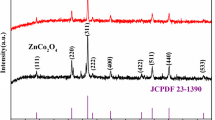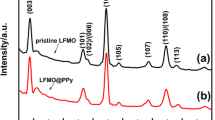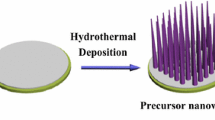Abstract
A novel set of CuO/PPy nanocomposites (NCs) with varying PPy weight ratios was synthesized via microwave irradiation and oxidative chemical polymerization. The resulting NCs and CuO micro-flowers were characterized by X-ray diffraction, Fourier transform infrared spectroscopy, thermogravimetric analysis, Brunauer–Emmett–Teller analysis, field-emission scanning electron microscopy, energy-dispersive X-ray spectroscopy line, and dot mapping techniques. The formation mechanism of CuO micro-flowers and PPy nanowires were discussed in detail. The electrochemical lithium-ion storage properties of all samples, used as anode materials in Li-ion batteries, were measured. Our results indicate that PPy nanowires with various weight ratios play a critical role in the lithium storage properties of the hybrid CuO/PPy NCs. An increase in the nanowire mass ratio enhances the cyclic durability and charge/discharge capacities of the PPy/CuO NCs. Specifically, NCs containing 3.5-, 5-, 6.2-, and 8.8-wt% PPy nanowires exhibit reversible capacities of 128, 231, 371, and 200 mAh g−1, respectively. The superior performance of the hybrid CuO/PPy NCs is attributed to the PPy nanowires. The CuO/PPy NCs benefit from the nanowire morphology and composite structural features that can accommodate the dramatic volume expansion of CuO during discharge/charge steps and enhance electrical conductivity. Our study demonstrates that tuning the PPy nanowire mass ratio in hybrid Metal Oxide/Polymer NCs is an effective method to enhance the electrode performance of an energy storage device.
Graphical abstract










Similar content being viewed by others
References
Cheng F, Liang J, Tao Z, Chen J (2011) Functional materials for rechargeable batteries. Adv Mater 23(15):1695–1715
Espinoza VS, Erbis S, Pourzahedi L, Eckelman MJ, Isaacs JA (2014) Material flow analysis of carbon nanotube lithium-ion batteries used in portable computers. ACS Sustain Chem Eng 2(7):1642–1648
Jin L, Qiu Y, Deng H, Li W, Li H, Yang S (2011) Hollow CuFe2O4 spheres encapsulated in carbon shells as an anode material for rechargeable lithium-ion batteries. Electrochim Acta 56(25):9127–9132
Jiang Y, Jiang Z, Jiang Z, Liu M (2018) Phase and morphology evolution induced lithium storage capacity enhancement of porous CoO nanowires intertwined with reduced graphene oxide nanosheets. ChemElectroChem 5(23):3679–3687
Zhang Q et al (2014) CuO nanostructures: synthesis, characterization, growth mechanisms, fundamental properties, and applications. Prog Mater Sci 60:208–337
Ding Y, Yang Y, Shao H (2012) Synthesis and characterization of nanostructured CuFe2O4 anode material for lithium ion battery. Solid State Ionics 217:27–33
Hou Q et al (2019) Encapsulation of Fe2O3/NiO and Fe2O3/Co3O4 nanosheets into conductive polypyrrole for superior lithium ion storage. Electrochim Acta 296:438–449
Cheng Y-W et al (2018) Freestanding three-dimensional CuO/NiO core–shell nanowire arrays as high-performance lithium-ion battery anode. Sci Rep 8(1):18034
Wang C, Xu J, Ma R, Yuen M-F (2014) Facile synthesis of CuO nanoneedle electrodes for high-performance lithium-ion batteries. Mater Chem Phys 148(1–2):411–415
Pal J, Mondal C, Sasmal AK, Ganguly M, Negishi Y, Pal T (2014) Account of nitroarene reduction with size-and facet-controlled CuO–MnO2 nanocomposites. ACS Appl Mater Interfaces 6(12):9173–9184
Zhang X et al (2018) Room-temperature vertically-aligned copper oxide nanoblades synthesized by electrochemical restructuring of copper hydroxide nanorods: an electrode for high energy density hybrid device. J Power Sour 383:124–132
Chen Z et al (2019) Ultrafine CuO nanoparticles decorated activated tube-like carbon as advanced anode for lithium-ion batteries. Electrochim Acta 296:206–213
Wang C et al (2014) Morphology-dependent performance of CuO anodes via facile and controllable synthesis for lithium-ion batteries. ACS Appl Mater Interfaces 6(2):1243–1250
Oh SW, Bang HJ, Bae YC, Sun Y-K (2007) Effect of calcination temperature on morphology, crystallinity and electrochemical properties of nano-crystalline metal oxides (Co3O4, CuO, and NiO) prepared via ultrasonic spray pyrolysis. J Power Sour 173(1):502–509
Xiang JY, Tu JP, Zhang L, Zhou Y, Wang XL, Shi SJ (2010) Self-assembled synthesis of hierarchical nanostructured CuO with various morphologies and their application as anodes for lithium ion batteries. J Power Sources 195(1):313–319
Morales J, Sánchez L, Martín F, Ramos-Barrado JR, Sánchez M (2004) Nanostructured CuO thin film electrodes prepared by spray pyrolysis: a simple method for enhancing the electrochemical performance of CuO in lithium cells. Electrochim Acta 49(26):4589–4597
Park JC, Kim J, Kwon H, Song H (2009) Gram-scale synthesis of Cu2O nanocubes and subsequent oxidation to CuO hollow nanostructures for lithium-ion battery anode materials. Adv Mater 21(7):803–807
Gao XP et al (2004) Preparation and electrochemical performance of polycrystalline and single crystalline CuO nanorods as anode materials for Li ion battery. J Phys Chem B 108(18):5547–5551
Moakhar RS et al (2020) One-pot microwave synthesis of hierarchical C-doped CuO dandelions/g-C3N4 nanocomposite with enhanced photostability for photoelectrochemical water splitting. Appl Surf Sci 530:147271
Huang XH, Tu JP, Xia XH, Wang XL, Xiang JY (2008) Nickel foam-supported porous NiO/polyaniline film as anode for lithium ion batteries. Electrochem Commun 10(9):1288–1290
Liu R, Duay J, Lee SB (2010) Redox exchange induced MnO2 nanoparticle enrichment in poly (3, 4-ethylenedioxythiophene) nanowires for electrochemical energy storage. ACS Nano 4(7):4299–4307
Sun X, Zhang H, Zhou L, Huang X, Yu C (2016) Polypyrrole-coated zinc ferrite hollow spheres with improved cycling stability for lithium-ion batteries. Small 12(27):3732–3737
Wu L et al (2019) PPy-encapsulated SnS2 nanosheets stabilized by defects on a TiO2 support as a durable anode material for lithium-ion batteries. Angew Chemie 131(3):821–825
Yin Z, Ding Y, Zheng Q, Guan L (2012) CuO/polypyrrole core–shell nanocomposites as anode materials for lithium-ion batteries. Electrochem Commun 20:40–43
Yin Z, Fan W, Ding Y, Li J, Guan L, Zheng Q (2015) Shell structure control of PPy-modified CuO composite nanoleaves for lithium batteries with improved cyclic performance. ACS Sustain Chem Eng 3(3):507–517
Feng L et al (2020) Preparation of CuO@ PPy hybrid nanomaterials as high cyclic stability anode of lithium-ion battery. Micro Nano Lett 15(7):441–445
Batool A, Kanwal F, Imran M, Jamil T, Siddiqi SA (2012) Synthesis of polypyrrole/zinc oxide composites and study of their structural, thermal and electrical properties. Synth Met 161(23–24):2753–2758
Zhao J, Zhang S, Liu W, Du Z, Fang H (2014) Fe3O4/PPy composite nanospheres as anode for lithium-ion batteries with superior cycling performance. Electrochim Acta 121:428–433
Zou G, Li H, Zhang D, Xiong K, Dong C, Qian Y (2006) Well-aligned arrays of CuO nanoplatelets. J Phys Chem B 110(4):1632–1637
Wang B, Wu X-L, Shu C-Y, Guo Y-G, Wang C-R (2010) Synthesis of CuO/graphene nanocomposite as a high-performance anode material for lithium-ion batteries. J Mater Chem 20(47):10661–10664
Zhou Y et al (2019) Evaporation induced uniform polypyrrole coating on CuO arrays for free-standing high lithium storage anode. J Solid State Electrochem 23(6):1829–1836
Cho G, Fung BM, Glatzhofer DT, Lee J-S, Shul Y-G (2001) Preparation and characterization of polypyrrole-coated nanosized novel ceramics. Langmuir 17(2):456–461
Thommes M et al (2015) Physisorption of gases, with special reference to the evaluation of surface area and pore size distribution (IUPAC Technical Report). Pure Appl Chem 87(9–10):1051–1069
Yang C, Xiao F, Wang J, Su X (2015) 3D flower-and 2D sheet-like CuO nanostructures: microwave-assisted synthesis and application in gas sensors. Sensors Actuators B Chem 207:177–185
Volanti DP et al (2008) Synthesis and characterization of CuO flower-nanostructure processing by a domestic hydrothermal microwave. J Alloys Compd 459(1–2):537–542
Yang G, Park S-J (2019) Conventional and microwave hydrothermal synthesis and application of functional materials: a review. Materials (Basel) 12(7):1177
Rangel-Yagui CO, Pessoa-Jr A, Blankschtein D (2004) Two-phase aqueous micellar systems: an alternative method for protein purification. Brazilian J Chem Eng 21(4):531–544
Dai T, Yang X, Lu Y (2006) Controlled growth of polypyrrole nanotubule/wire in the presence of a cationic surfactant. Nanotechnology 17(12):3028
Yin Z, Zheng Q (2012) Controlled synthesis and energy applications of one-dimensional conducting polymer nanostructures: an overview. Adv Energy Mater 2(2):179–218
Xiang JY, Tu JP, Zhang J, Zhong J, Zhang D, Cheng JP (2010) Incorporation of MWCNTs into leaf-like CuO nanoplates for superior reversible Li-ion storage. Electrochem Commun 12(8):1103–1107
Vahdatkhah P, Sadrnezhaad SK, Voznyy O (2022) On the functionality of the polypyrrole nanostructures for surface modification of Co-free Li-rich layered oxide cathode applied in lithium-ion batteries. J Electroanal Chem 914:116317
Park S-K, Choi JH, Kang YC (2018) Unique hollow NiO nanooctahedrons fabricated through the Kirkendall effect as anodes for enhanced lithium-ion storage. Chem Eng J 354:327–334
Wang Y et al (2020) Cu/Cu2O@ Ppy nanowires as a long-life and high-capacity anode for lithium ion battery. Chem Eng J 391:123597
Author information
Authors and Affiliations
Contributions
Conceptualization: PV, SMHH, MH, SKS. Methodology: SMHH, MH. Formal analysis and investigation: MH. Writing—original draft preparation: MH. Writing—review, and editing: SKS, MH, PV. Resources: SKS. Supervision: SKS. All authors read and approved the final manuscript.
Corresponding author
Ethics declarations
Competing interests
The authors declare no competing interests.
Additional information
Publisher's Note
Springer Nature remains neutral with regard to jurisdictional claims in published maps and institutional affiliations.
Rights and permissions
Springer Nature or its licensor (e.g. a society or other partner) holds exclusive rights to this article under a publishing agreement with the author(s) or other rightsholder(s); author self-archiving of the accepted manuscript version of this article is solely governed by the terms of such publishing agreement and applicable law.
About this article
Cite this article
Helli, M., Sadrnezhaad, S.K., Hosseini-Hosseinabad, S.M. et al. Synthesis and characterization of CuO micro-flowers/PPy nanowires nanocomposites as high-capacity anode material for lithium-ion batteries. J Appl Electrochem 54, 1–11 (2024). https://doi.org/10.1007/s10800-023-01955-3
Received:
Accepted:
Published:
Issue Date:
DOI: https://doi.org/10.1007/s10800-023-01955-3




